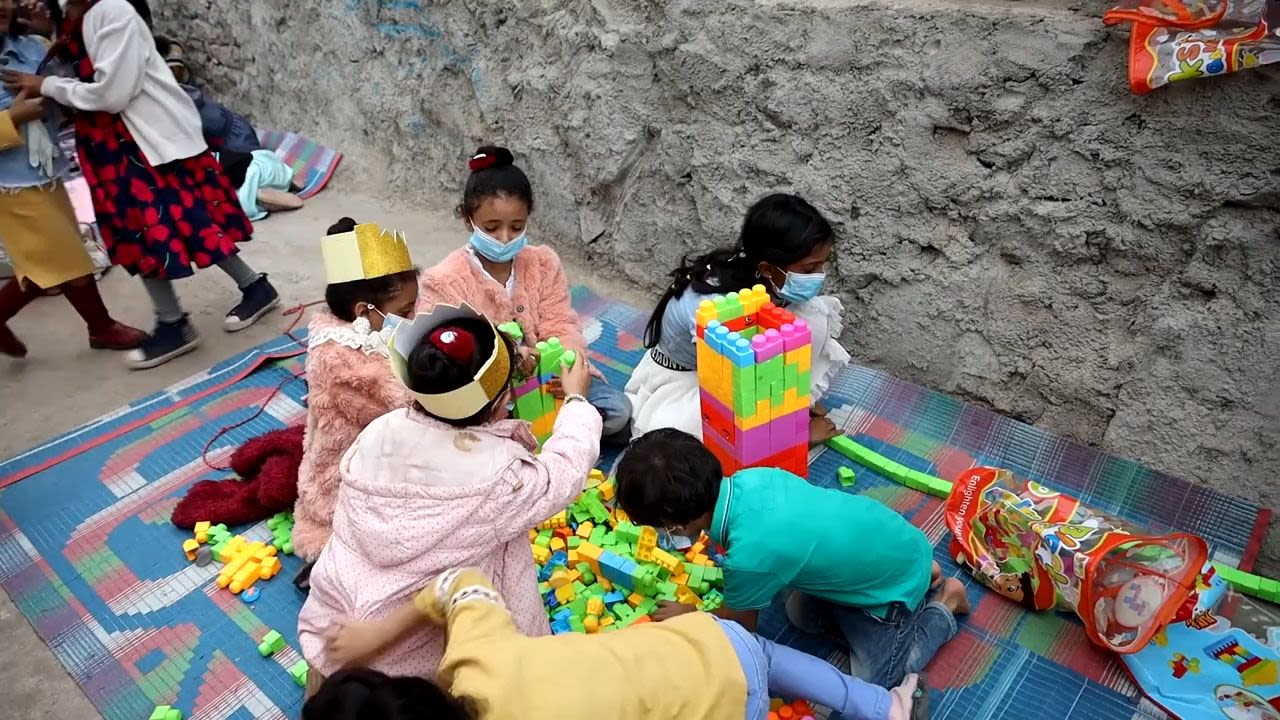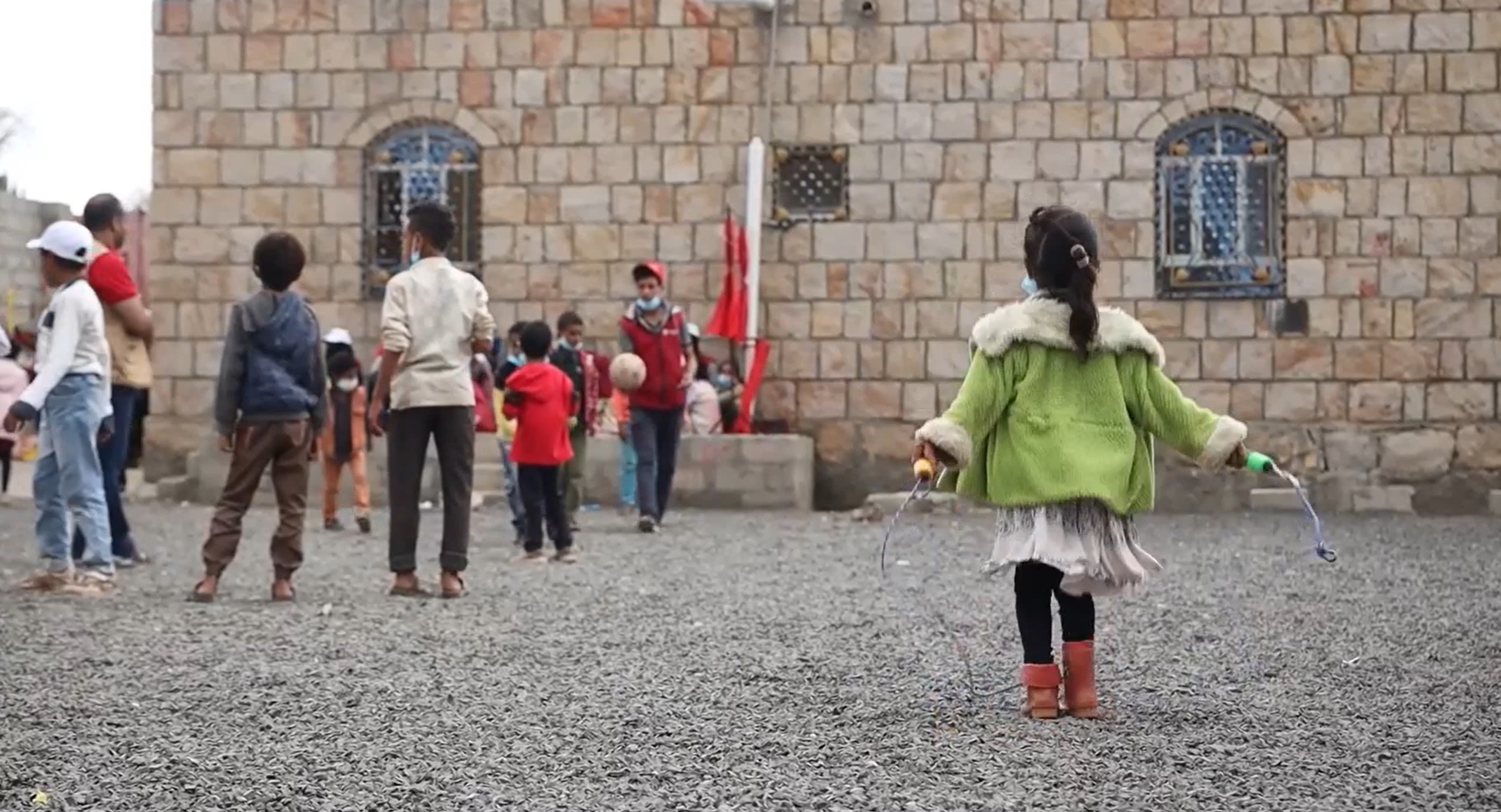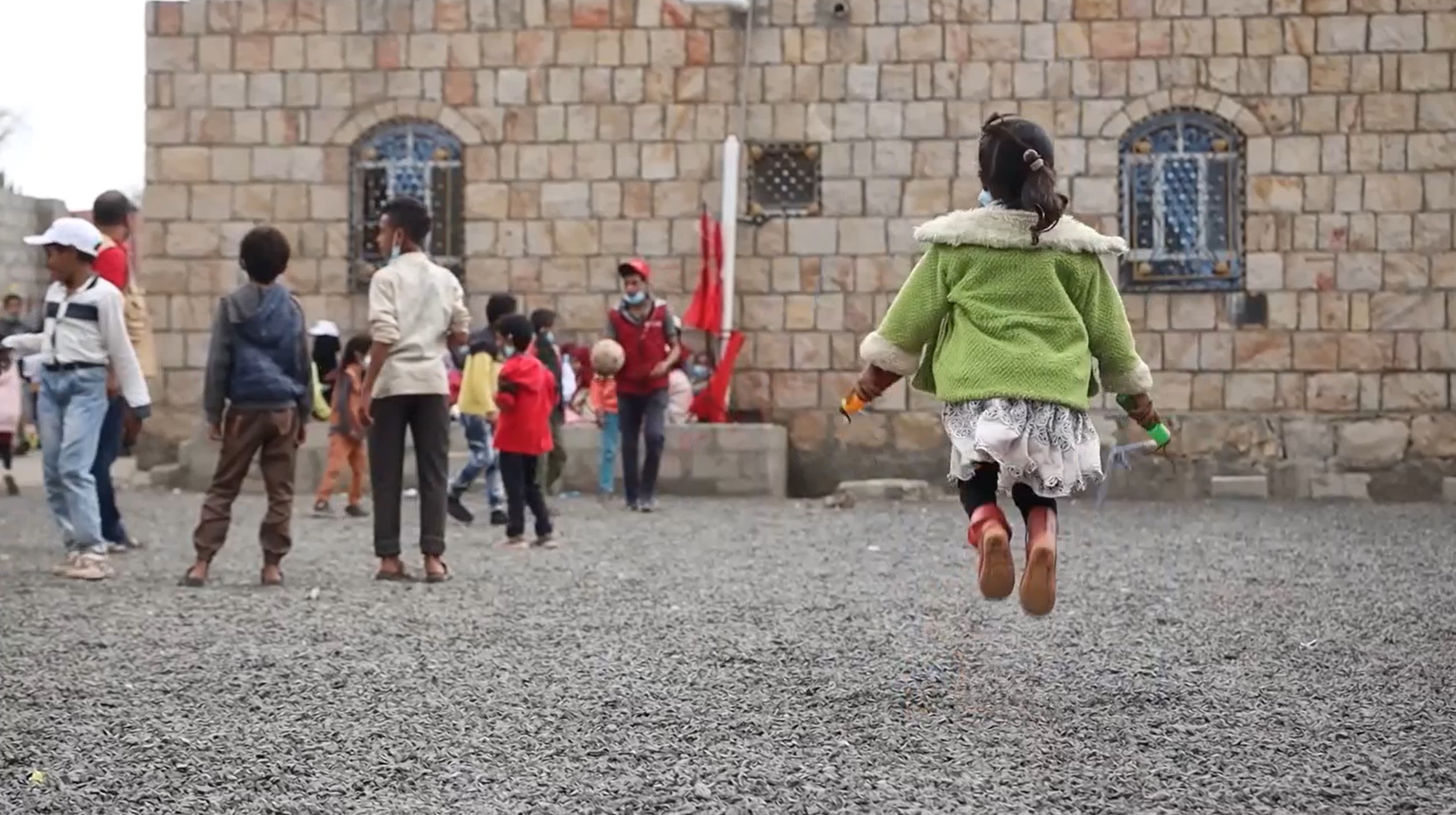THE POWER OF A SAFE PLACE TO PLAY

More children than ever before are living in conflict zones.
Fighting, violence, destruction of homes and communities, as well as loss of family, and schools can affect children’s physical and mental well-being. Additional insecurities around money, food, warmth and shelter can cause stress, anxiety and abuse at home.
Without the right support, the psychological toll of conflict on children can be huge on children’s well-being and long-term development.
Every child, no matter where they live, deserves to live a safe, happy and healthy life.
Save the Children has been able to help children to better cope with their experiences through mental health, and psychosocial support, often delivered through our Child-Friendly Spaces.
Continue scrolling or click the menu along the top to learn how Save the Children supports children's well-being in some of the world's most challenging conflict zones.
* Names have been changed to protect identity.

What is a Child-Friendly Space?
These are safe spaces where children can redevelop emotional relationships and resume social practices that have been interrupted by conflict. They can play and be children.
Through play, children can explore and understand emotions and experiences. Play fuels curiosity, sparks creativity and inspires a lifelong love of learning. This is especially powerful in times of crisis to help children overcome what they have experienced.
In Syria, Ukraine and Yemen, Save the Children programmes offer a variety of activities to support children’s mental health and psychosocial well-being.
To support children in the best way we can, there is something for everyone. There is something for the animal and game lovers, the artists, as well as the crafty, playful and sporty children.
Kindergarten children play and learn at a Child-Friendly Space in Ukraine. Photo: Oleksandr Khomenko / Save the Children.
Kindergarten children play and learn at a Child-Friendly Space in Ukraine. Photo: Oleksandr Khomenko / Save the Children.
For the animal lovers

In Kyiv, Ukraine, Save the Children is supporting Your Way, an NGO running Child-Friendly Spaces which offers support to children and their families via specialists - including canine therapists.
To help 9-year-old Victoriya* process her experiences of the war in Ukraine, she has benefitted from canine therapy with Parker the golden retriever.
Parker is a therapy dog. Therapy dogs - or any therapy animal - can help children to open up more easily. Nataliya is a canine therapy specialist who works with Victoriya. She explains:
A canine therapy dog is focused on human stress. It’s focusing on finding and reducing stress.
Nataliya (left) and Olena (right), canine therapy specialists, with therapy dogs golden retriever Parker and border collie Best at a school outside of Kyiv, Ukraine. Photo: Oleksandr Khomenko / Save the Children.
Nataliya (left) and Olena (right), canine therapy specialists, with therapy dogs golden retriever Parker and border collie Best at a school outside of Kyiv, Ukraine. Photo: Oleksandr Khomenko / Save the Children.
Once Parker senses a child's stress he reacts. Nataliya can then read this reaction to identify what Parker sees in the child.
The main thing that a dog does is a mechanism called grounding. This is when people [can] feel themselves here and now and switch to other thoughts instead of thinking about the past or worrying about the future."
Viktoriya poses with therapy dog Parker at a school outside of Kyiv, Ukraine. Photo: Oleksandr Khomenko / Save the Children.
Viktoriya poses with therapy dog Parker at a school outside of Kyiv, Ukraine. Photo: Oleksandr Khomenko / Save the Children.
Please donate to help children like Victoriya living in crisis globally.


For the playful ones

Social Centres, like Child-Friendly Spaces, are important places for children in Yemen to learn and play.
They give children a special place to be with their friends, play, be children and have a break from the ongoing conflict.
At this social centre in Taiz, Yemen, Osama's* favourite game to play with his friends is dress up.
Osama* plays dress up at the social centre in Taiz, Yemen. Photo: Save the Children.
Osama* plays dress up at the social centre in Taiz, Yemen. Photo: Save the Children.
Other children enjoy learning new skills such as hairdressing or sewing.
The minute I enter the centre, I feel I have gone to a place where I learn beautiful things that I didn’t know about before.
Latifa* learns to sew at the social centre in Taiz, Yemen. Photo: Save the Children.
Latifa* learns to sew at the social centre in Taiz, Yemen. Photo: Save the Children.
All the children that attend the social centre enjoy having a safe place to play.
We come to the community centre to play instead of playing out in the dirt.
Children playing with blocks at the social centre Taiz, Yemen. Photo: Save the Children.
Children playing with blocks at the social centre Taiz, Yemen. Photo: Save the Children.
Please donate to our Children's Emergency Fund to help children living in crisis in countries like Yemen and around the world.



For the artists

Healing and Education through the Arts for children programme (HEART) was designed by Save the Children as a form of psychosocial support. Through arts-based group activities, children benefit from learning to adapt and overcome the distressing situations they have experienced.
In Poltava, Ukraine, Anton* attends an art centre supported by Save the Children. He participates in candle-making classes, computer 2D graphic lessons, and painting.
Anton*, 12, paints during an art therapy workshop in Poltava, Ukraine. Photo: Oleksandr Khomenko / Save the Children.
Anton*, 12, paints during an art therapy workshop in Poltava, Ukraine. Photo: Oleksandr Khomenko / Save the Children.
Since attending the art centre, Anton has discovered a new love for painting and he enjoys the distraction from the ongoing war.
My dream is for the bad things that happen to end and to return home. This is my biggest dream.
Yaroslav and Alina, Founders of a Save the Children supported club, in Poltava, Ukraine. Photo: Oleksandr Khomenko / Save the Children.
Yaroslav and Alina, Founders of a Save the Children supported club, in Poltava, Ukraine. Photo: Oleksandr Khomenko / Save the Children.
Founders of the art centre, Yaroslav and Alina, explain the importance of the art centre for children to express their feelings:
It’s necessary for a child to express their troubles, what hurts, because maybe for us it isn’t a problem, but for a child it’s a big lump that they cannot share.
Please donate to support children living through emergencies in countries like Ukraine and worldwide.

For the creators

In this Child-Friendly Space at Al Hol displacement camp in Syria, 11-year-old Amal* and her friends let their imaginations run wild and love to create masterpieces.
In this space, children are able to participate in craft workshops to help them relax, de-stress, and improve their overall mental well-being.
11-year-old Amal* (left) works on her craft project with her friends in the Child-Friendly Space, Syria. Photo: Muhannad Khaled / Save the Children.
11-year-old Amal* (left) works on her craft project with her friends in the Child-Friendly Space, Syria. Photo: Muhannad Khaled / Save the Children.
Amal has been living in Al Hol Camp, for the past five years since her family was displaced by conflict. By attending Save the Children’s Child-Friendly Space, Amal has been able to disconnect from the reality of conflict and displacement.
Amal was introduced to arts and crafts by our specialist staff. She loved it so much that she now wants to be an architect when she is older.
My first project will be building a school for children to learn.
Please donate to help children living in conflict in countries like Syria and around the world.


For the game lovers

Children in Syria have only ever known fighting and violence. This includes children like Nerjis*.
When fleeing her city, 8-year-old Nerjis became injured and had to have three of the fingers on her left hand amputated. This had a huge impact on Nerjis.
Nerjis became introverted and refused to go to school or to see other children. Nerjis was left-handed, so she found it hard to adjust to doing things with her right hand.
Eventually, her mother, Alif* persuaded her to attend a school where Save the Children had set up a Child-Friendly Space for children impacted by the conflict in Syria.
Nerjis* plays games at the Save the Children Child-Friendly Space. Photo: Shiyar Omar / Save the Children.
Nerjis* plays games at the Save the Children Child-Friendly Space. Photo: Shiyar Omar / Save the Children.
Nerjis was encouraged to participate in activities and games with other children.
My teacher [Save the Children Protection Facilitator] taught me how to write with my right hand. I was very happy when I learned how to do it.
All of this helped Nerjis gain more confidence. Now, she dreams of becoming a teacher when she grows up.
Without Save the Children my daughter would not be able to overcome her agony.
Please donate to help children like Nerjis piece their lives back together.

For the sport fans

Ammar* is 11 years old. He lost his leg after stepping on a landmine when fleeing conflict in Syria several years ago.
Ammar loves football and watched other children playing football at the displacement camp where he lives. However, he wasn’t allowed to join them because they said that his leg injury slowed them down. His mother, Hafiza*, said:
Ammar couldn’t run, play, or attend school like the other children in the displacement camp.
Hafiza enrolled Ammar in a school and a Child-Friendly Space supported by Save the Children to help him adapt to his new life and learn how to read and write.
At the Child-Friendly Space, I made many new friends. We play, laugh and have a lot of fun together. I forget about my leg when I am there.
Ammar*, 11, playing football with his friend Ahmed* at a Child-Friendly Space in Syria. Photo: Roni Ahmed / Save the Children.
Ammar*, 11, playing football with his friend Ahmed* at a Child-Friendly Space in Syria. Photo: Roni Ahmed / Save the Children.
Ammar's mother never imagined the positive impact that the Child-Friendly Space would have on her son's daily life.
I will never forget the smile on his face after he came back from his first day. He told me how the teacher and the students played with him.
Please donate to help children like Ammar recover from conflict.

More than 1 in 5 children have no safe place to play.
Save the Children, along with its partners, is working across the world to provide children in conflict zones with immediate and long-term support to rebuild their lives.
Every child, no matter where they live, deserves to live a safe, happy and healthy life.
But, we can't do this without support from people like you. Please donate to help children living in conflict in countries around the world.













